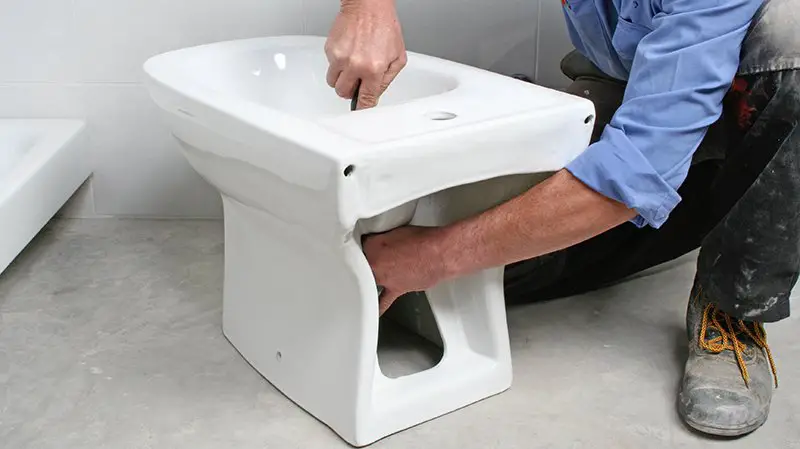How to Install a Toilet Flange in New Construction?

New construction sometimes leaves completely unfinished soil pipes. If you want to set up a toilet, you will need to do a little more than just screwing it in place.
You will need to make the soil pipe flush with the ground. Next, you will need to clean, deburr, and prime the soil pipe and the flange. Then, cover both the outside of the closet flange and the inside of the soil pipe.
The soil pipe in new construction is rarely flush with the ground. The advantage is that unlike standard rough-in pipes in basements, typically, the floor has not been recoated, so the pipe sticks out instead of being recessed. So, it is easy to simply cut down and prepare, and here is how.
Measure the distance from the wall. This is important for determining what kind of toilet you will be able to use. This determines whether you will want to use an offset flange to move the toilet closer or farther from the wall. Measure from the wall to the center of the flange; it should be about 10 or 12 inches from the wall.
Measure the diameter of the pipe. You need to measure the pipe diameter; you have to figure out what flange diameter you will need. Typically these come in sizes between 2 and 4 inches.
Cut the pipe. You can use any kind of saw, but just make it flush with the floor. A reciprocating saw like a Sawzall makes a good choice because it can flex to get a good flush cut.
Prepare the pipe. Use sandpaper or a deburring tool to deburr the pipe; do this for the closet flange as well. Make sure it is smooth, and you avoid removing material. Afterward, wipe it down thoroughly with a damp rag and then a dry one to make sure it is completely clean and dry before proceeding.
Now that you have prepared and cleaned the pipe, you can start with the flange. Make sure that the flange you have is the correct diameter for your pipe. Here is how to install it.
You’ve installed your toilet flange. From here, if you want to install a toilet, you have completed the most challenging part already. However, you will still need to install a shutoff valve on the cold water supply, and then install the toilet itself.
Yes, the toilet flange should be flush with the floor, if possible. By this, we mean that the flange should be resting on top of the finished floor. This is so that the floor can support the toilet’s weight and minimize the distance between the sealing surfaces.
This reduces the chance of leaks. If you have a rocking toilet, you may find that your toilet flange was set too high.
Yes, the toilet flange should rest on whatever surface your toilet is. If the flange rests above the floor, it can cause the toilet to wobble and break the seal causing leaks.
On the other hand, if the seal is too low, it leaves empty space filled only by the wax seal. This is bad because the wax seal is designed to be pressed against the toilet, not to fill large amounts of empty space. This likely will cause it to leak in time.
The toilet flange cannot be lower than the floor, or the toilet will likely leak. Depending on how much lower, space may not even be filled by the wax seal. This will leave a lot of leaking, possibly even sewer gas leaking out.
If your toilet’s soil pipe is too low, you should install an extension flange to put it on top of your floor. This will allow you to bolt it to the floor. This will hold your toilet to your floor, prevent movement, and extend your wax seal’s life.
If your flange is too high, you need to either support it or replace it. If the gap isn’t too large, it will probably be easier to do the former.
Your options for filling the gap are:
Fill the gap with grout. You can purchase grout in most hardware stores. Simply use a putty knife to pack the gap thickly with grout all the way around. Wait at least 24 hours before using the toilet to allow it to dry.
Overlay the floor. If your flooring is tile or another solid material that can be overlayed, you may be able to raise the flooring and the toilet. You can overlay your floor as many times as you need to fill the gap.
Replace the flange. First, check if the soil pipe itself is too long or if the toilet flange is at fault. If the soil pipe is too long, cut it, and install a new flange in the stump. Otherwise, remove the existing flange and replace it at the correct level.
It is possible to mount the toilet to the floor directly; however, this isn’t advisable. The flange provides a proper surface for the wax seal to bond to as well as the toilet. It also prevents gaps between the soil pipe and the toilet and holds your toilet to the floor.
Though it is possible to design your own system to solve some of these problems, it is better to install a toilet flange. If degradation prevents a flange from being installed, a plumber can install a new pipe section to connect a flange to.